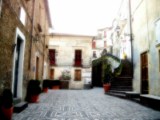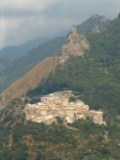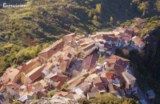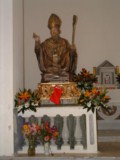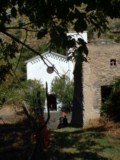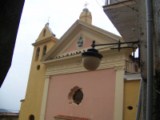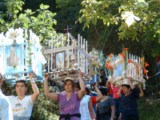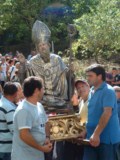|
BUONVICINO - CALABRIA- SOUTH ITALY This small village appears almost unexpectedly, between the green mountains and hill tops.
Buonvicino celebrates a very important event that brings many visitors to this small town during the feast for "Santo Ciriaco" in Buonvicino-Cosenza, the inhabitants (about 3000 of population) create a respectful combination of praying and reverence with music, dancing and eating; this feast lasts five days and five nights in the "paese" (town center) but begins with a "Town Picnic" down at the "Grotto of Santo Ciriaco" where the Saint used to pass his days praying. Buonvicino is an Italian town of 2,324 inhabitants in the province of Cosenza in Calabria. History Buonvicino was founded in the late thirteenth century by the inhabitants of three houses: Saved Tripidonee Trigiano near the Abbey of San Ciriaco. Saved was perched on the cliff right of the "Straits". The primitive dwellings were on "Rock of the Greek" of which traces remain visible and surface excavations. Excavations carried out in 1978 and 20 February 1997 were found broken tiles, dishes and animal bones. The inhabitants were engaged in farming and forestry activities. On the opposite side, ie on the rocky ridge of the cliff was left there Tripidone (ibid., poking some places the walls to the north-east of the "Straits", was found a dagger of iron craftsmanship). These primitive villages had little land available for the most part made up of woods and mountains. Further away, on the south-west, near the border of the Belvedere, stood the house of Trigiano he owned throughout the campaign Buonvicino including the area where once stood the monastery of San Ciriaco. The three houses Along the way from the valley of the isthmus leading to Corvino "Varco Palomabaro of" one is forced to move in the midst of a horrible throat, just 5 meters wide, called "Strait", consists of two high rocky cliffs on the tops of which, to the right of Corvino, is "Rock of the Greek" a small plateau that is part of the area known as Salvato and on the left, in a valley bordered by three summits, there is Tripidone. They were inhabited villages, from the earliest times remote from the primitive tribe of Greek origin. The battles with the Samnites, the Roman occupation, barbarian invasions, the Saracens, led to the disappearance of Laos and Cider. Along the way isthmic life was not entirely extinguished, but had spread terror and death always lurking. That's why the people of the Cape and Castellucce thought of abandoning their habitations insecure and find refuge in Saved, a high and inaccessible rock, still called the "Rock of the Greek". Others had secured the home, some time ago, on the left side of the "tight", also hidden and inaccessible, which called for the presence of three peaks of rocks equidistant Tripidone. Trigiano, but was located further away, near Maritime lookout; house was autonomous and covered the whole territory of today's campaign Buonvicino. The inhabitants of Saved Tripidone and were devoted to sheep farming and forestry activities, while those of Trigiano agriculture because they can cultivate many fields. These three villages were located along the isthmus in position to observe the continuous traffic that is not dangerous because they defended well, of course. The union of these three Houses, the late thirteenth century, gave rise to Buonvicino. Now dominates the country the huge bronze statue of San Ciriaco Abate 7 meters, situated on a rock "Zaccaniello" dominating the country |
||||||||||


